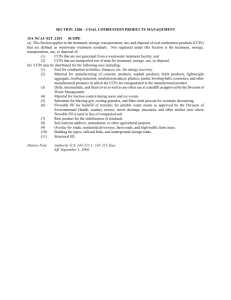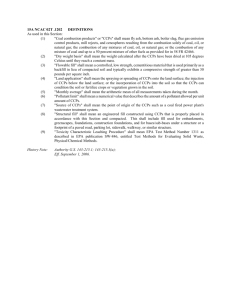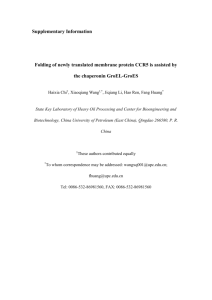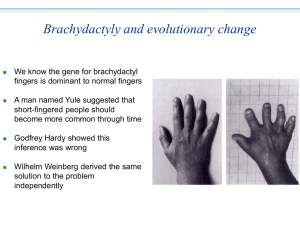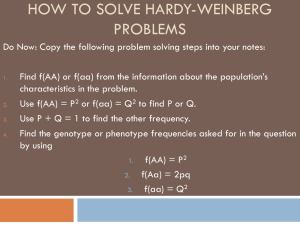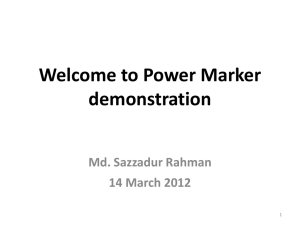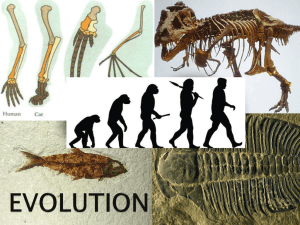PowerPoint used to create video
advertisement
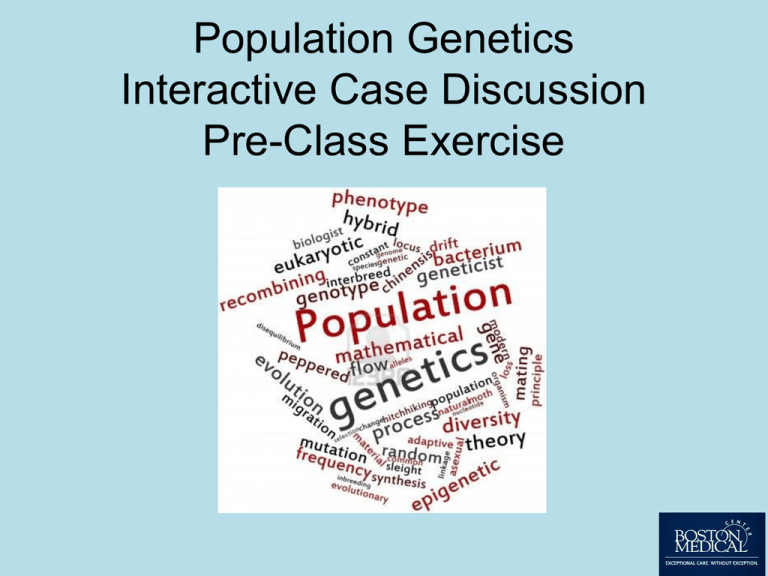
Population Genetics Interactive Case Discussion Pre-Class Exercise Learning Objectives By the end of this session, students should be able to… 1. 2. 3. 4. 5. Illustrate how historical human migration patterns have contributed to genetic variation observed in modern populations. Differentiate between population subgroups defined by racial categories or geographic ancestry in terms of genetic variation. Use the principles of population genetics (e.g. founder effect, Hardy-Weinberg equilibrium, selection pressure) to predict frequencies of alleles and genotypes in a given population. Evaluate the significance of identifying the presence of disease alleles on the health care system and on individuals acquiring this information directly, in the absence of the guidance of a health care professional. Assess the implications of evolving genetic testing technologies on yielding false negative results and the validity of the duty to recontact concept. Population Genetics Why is Population Genetics Important? • Study of genetic variation in a population and how the frequency of a gene or allele in that population changes • Forms the basis of genetic counseling and the estimation of risk calculations • As of 1/2013, 22,000 known single gene traits defined in humans that lead to genetic diseases (OMIM) The Genographic Project Image retrieved from http://3cpg.cornell.edu/index.cfm/page/AncestryProject/AncestryEventsSpr2011.html on July 25, Geographic Ancestry • Genetic research has recently focused on the migration of ancestral human populations into different geographic areas • Using genome wide association studies, it is possible to determine the geographic ancestry of a person, the degree of ancestry from different regions, and migrational history • Due to group endogamy (marrying within a specific group), allele frequencies cluster around specific regions or ancestries. Reich et al in Nature examined genomes of 125 individuals from 25 social, language, and geographic groups in India. They found: • • • Indian populations bear the genetic imprint of European, Asian, and even African genomes Genetic diversity in India is 3x more than in Europe Most Indian populations have a 3971% mixture of variation from ancestral North India and ancestral South India D Reich et al. Nature 461, 489-494 (2009) doi:10.1038/nature08365 The Founder Effect When a small subpopulation breaks off from a larger population, gene frequencies might change. If one of the “founders” of this new population is a carrier of a rare allele, then that allele will have a far higher frequency than it had in the larger group. • Lac St. Jean, Quebec and type I tyrosinemia • Martha’s Vineyard and hereditary deafness CCR5: a protein cytokine receptor • CCR5 (c-c chemokine receptor 5) is a protein receptor for cytokines (immune system attractant molecules) on the surface of many immune cells, including T cells, immature dendritic cells and mature macrophages. • A number of inflammatory CCchemokines, including MIP-1 alpha, MIP-1 beta, RANTES, MCP-2, and HCC-1 act as CCR5 agonists, while MCP-3 is a natural antagonist of the receptor. • The CCR5 gene is located on the p arm at position 21 on chromosome 3. Nature Immunology 6, 427 - 428 (2005) CCR5 plays a major role in HIV pathogenesis CCR5 and CD4 are binding proteins for the macrophage tropic lines of HIV 1 and HIV 2 viral particles gp41 and gp120 to mediate attachment to the T cell and subsequently infect. CCR5 and HIV resistance CCR5 is a 32 base pair deletion that leads to a frameshift mutation and nonfunctional protein. • Common in individuals of Northern European ancestry • Homozygote individuals do not express this receptor on the surface of their CD4 T cells and exhibit resistance to HIV infection. • Heterozygote individuals exhibit a delay in progression to AIDS CCR5 and HIV resistance 1 2 3 4 5 6 www.cdc.gov, accessed 10/8/12 7 8 - CCR5 is detectable by gene PCR - no known clinical implications of homozygotes or heterozygotes other than HIV resistance Martinson et al. Nature Genetics Genotype Individuals Genotype Frequency CCR5/CCR5 647 0.821 CCR5/CCR5 134 0.168 CCR5/CCR5 7 0.011 total 788 1 We know the genotype frequencies from the study results Calculation 1: CCR5 allele: (2x647) + (1x134) / 788x2 = 0.906 Calculation 2: CCR5 allele: (2x7) + (1x134) / 788x2 = 0.094 Could you have obtained the allelic frequency of the CCR5 allele without calculation 2? Yes – just subtract the frequency of the CCR5 allele from 1 (as the frequency of two alleles must add up to 1). Martinson, Chapman, and Rees et al performed PCR analysis of the CCR5 genes of 788 individuals in Europe in: Global distribution of the CCR5 gene 32 basepair deletion in Nature Genetics 16:100103, 1997. Hardy-Weinberg Equilibrium Dr. Hardy and Dr. Weinberg developed the below formula independently in 1908 (Dr. Geoffrey Hardy was an English mathematician, and Dr. Wilhelm Weinberg, a German physician) p+q=1 2 2 p + 2pq + q = 1 Some assumptions with HardyWeinberg equilibrium • The population is large and matings are random with regard to the genotype. Thus, genotype has no effect on mate selection. This allows the addition and multiplication rules to estimate genotype frequencies. • Allele frequencies are constant over time (as there is no appreciable rate of mutation, individuals with all genotypes are equally capable of mating and therefore passing along their genes, and no migration of individuals with allele frequencies different from the endogenous population) Hardy Weinberg equilibrium states that allele frequencies and genotype frequencies are related. Let’s say there are two alleles: A and a and three genotypes: AA, Aa, and aa. p is the frequency of allele A and q is the frequency of allele a. The probability that a sperm cell carrying allele A fertilizing an egg cell carrying A is p x p (or p2) . The probability that a sperm cell carrying allele a fertilizing an egg cell carrying a is q x q (or q2). What about the frequency of heterozygotes? Either a sperm cell carrying A can fertilize an egg carrying a or a sperm carrying a can fertilize an egg carrying A: (Aa x aA) = 2pq. The Hardy-Weinberg law states that the frequency of the three genotypes AA, Aa, and aa is given by p2 + 2pq + q2 = 1 and that p + q = 1. p2 + 2pq + q2 = 1 p = frequency of allele A q = frequency of allele a p2 = genotype frequency of individual AA q2 = genotype frequency of individual aa 2pq = genotype frequency of individual Aa You can use this framework to approach Hardy-Weinberg equilibrium problems Hardy-Weinberg equilibrium problem We found that the frequency of CCR5 allele (A) was 0.906 and the frequency of the CCR5 allele (a) is 0.094. p2 + 2pq + q2 = 1 p = 0.906 q = 0.094 p2 = genotype frequency of individual AA = 0.906 x 0.906 = 0.821 q2 = genotype frequency of individual aa = 0.094 x 0.094 = 0.009 2pq = genotype frequency of individual Aa = 2(0.906x0.094) = 0.170 Thus, by the Hardy-Weinberg equation, the genotype frequencies are… AA = 0.821 Aa = 0.170 aa = 0.009 these are the same frequencies measured in the Nature Genetics paper… Hardy-Weinberg and Autosomal Dominant Inheritance Marfan’s syndrome is an autosomal dominant connective tissue disorder which is characterized by a mutation in the FBN1 gene, which encodes fibrillin-1. Fibrillin-1 is a glycoprotein component of the extracellular matrix. More than 30 different signs and symptoms are associated with Marfan’s syndrome, including dolichostenomelia (long, slender limbs), arachnodactyly (long digits), ectopia lentis, and aortic insufficiency. The incidence of Marfan’s syndrome in a particular population is 1 in 100000 individuals. What is the allelic frequency of mutated fibrillin-1 in this population? In autosomal dominant disease, the components of Hardy-Weinberg equilibrium are a little different. 2pq = incidence of an autosomal dominant condition, includes only heterozygotes = 1 in 100000 or 0.00001 The allelic frequency of the diseased gene A (p) is usually very small, thus the allelic frequency of normal gene a (q) approximates 1. q=1 If incidence = 2pq, then p = incidence / 2 x 1 p = 0.00001/2 p = 0.000005 p2 = 2.5 x 10e-11 = 0 q2 = genotype frequency of indv aa = 1 – 2pq – p2 = 1 - 0.00001 – 0 = 0.99999 Hardy-Weinberg and X-linked Recessive Inheritance Protanopia is one type of red-green color blindness inherited in a X-linked recessive fashion. In a certain population, the prevalence of protanopic males is 1 in 100. What is the frequency of protanopic females? • As males are hemizygous for the X chromosome, a male individual only has only copy of each trait, indicating that the frequency of affected males is equal to the allele frequency. Thus q = 0.01 and p = 0.99. q = 0.01 p = 0.99 p2 = 0.9801 q2 = 0.0001 2pq = 0.0198 • An affected female would be have two affected copies of the allele – thus the frequency would be 0.0001. Selective Pressure What if enough time progressed to allow selection for the CCR5 gene? • Under selection, individuals with advantages or “adaptive traits” such as resistance to the HIV infection are more successful than their peers reproductively and they contribute more genetic material to the succeeding generation than other individuals do. • for example, mitochondrial DNA (mtDNA) is not controlled by the nucleus: within-cell selection can favor mtDNA variants with a replication advantage. Aanen and Maas, 2011 Would Hardy-Weinberg equilibrium truly apply going forward in this case of selection pressure? NO the allele frequencies are no longer constant Contact Information Katherine Larabee, MSIV klarabee@bu.edu, pager 0742 Shoumita Dasgupta, PhD dasgupta@bu.edu
